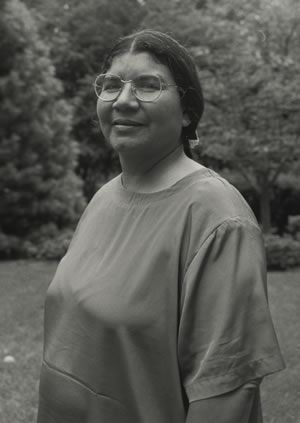Soccorro Hernandez Bernasconi
The native peoples of the Southwest have had to master the art of transformation. Carving an existence out of the difficult dry earth calls for creativity and persistence, and leaves no room for waste. Socorro Hernandez Bernasconi’s work in Guadalupe, a small town on the outskirts of Phoenix, Arizona, is very much a part of this resourceful tradition. She brings incredible will and an unusual ability to transform the minimum into enough, the ugly into the beautiful, and barriers into fuel to fight for the rights and autonomy of her community.
Socorro was born and raised in Guadalupe, a poor town with a population that is approximately 45 percent Yaqui Indian and 55 percent Latino. Socorro was the first person from Guadalupe to receive a college or Master’s degree. She never considered taking the rewards of her education anywhere but back to Guadalupe. “I went away and got an education so I could bring it back,” she says.
Upon her return, Socorro became the first Latina counselor in the Tempe district school system. She soon observed that an inordinate number of Guadalupe school children were being classified as mentally retarded based on standardized tests administered in English. Yaqui and Latino students made up only one-fifth of the entire Tempe school district population, but more than two-thirds of the special education classes. When Socorro protested this, she was told by the school district that she had no right to criticize school practices, and was promptly demoted to a position in a non-minority school. Socorro helped organize a lawsuit against the school district that was settled with a ruling that tests must be administered in the students’ native tongue, without cultural bias.
Having left an indelible mark on the public school system, Socorro branched out to help found an alternative, tri-lingual (Yaqui, English, and Spanish) school, which would emphasize the cultural heritage of its students. The I’Tom (Yaqui for “Our”) Escuela (Spanish for “School”) educated 200 children over a period of about ten years, operating on a $25,000 annual budget.
After Socorro was forced to close the school due to lack of funds, she became the director of the Refugio De Colores—a shelter from domestic violence that used traditional cultural practices and values to respond to the needs of minority women and children. There, she organized an annual month-long art exhibit for victims to display artworks depicting the many forms of abuse—physical, emotional, sexual, economic, and spiritual—transforming the anger, fear, and resentment that victimization causes into a creative form of self-expression and a successful community education tool.
To expand the shelter, Socorro once again demonstrated her remarkable ability to make something out of nothing. When her grant applications were denied by state agencies, Socorro went door to door through the community with the contractor’s list of materials needed for a second building. “I wouldn’t take no for answer,” she says. “With the little bit that we could get, we gave it a go.”
In the middle of her tenure as director of the shelter, Socorro’s 19-year-old son committed suicide. Her pain changed her focus to helping the at-risk teens of her community end gun violence. In 1995, Socorro resigned as head of the domestic violence shelter to devote her attention to creating a proactive anti-drug and violence program, which organizes vigils at the sites of violent crimes. GLAAD (Guadalupe Libre Alcohol Aarmas y Drogas) has sponsored four successful efforts to get local teens to exchange guns for such rewards as bicycles donated by the police, lessons given by local musicians, and computers from a local learning center.
Socorro uses the same creativity she applied to the issue of domestic violence to ensure that confiscated guns are not recycled back into the community. She encourages local artists and welders to turn them into symbolic pieces of art. The altar of the local church is flanked by two candlesticks made of rifle barrels; the shovel used to bury the last five victims of gun-violence is made out of a rifle. Socorro believes that “to educate an individual or a community, you need to impact all their senses.”
Socorro is proud of the fact that many of Guadalupe’s victories have been both funded and carried out by the community itself. In 1995, she helped start a scholarship fund to send Guadalupe youths to state colleges and junior colleges. This year she sent out letters to college graduates from Guadalupe asking them for their support and reminding them of how hard it had been to get through college. “I was humbled by the response,” she says, “I asked for ten dollars, but many people sent more—$50 or $100. We were able to fill all our scholarship requests.” Socorro Bernasconi takes heart in the way small triumphs can begin to transform an entire community. Guadalupe is “the candle you put on top of a mountain—a beacon to guide the way for others.”
 Photo by Dorothea von Haeften
Photo by Dorothea von Haeften